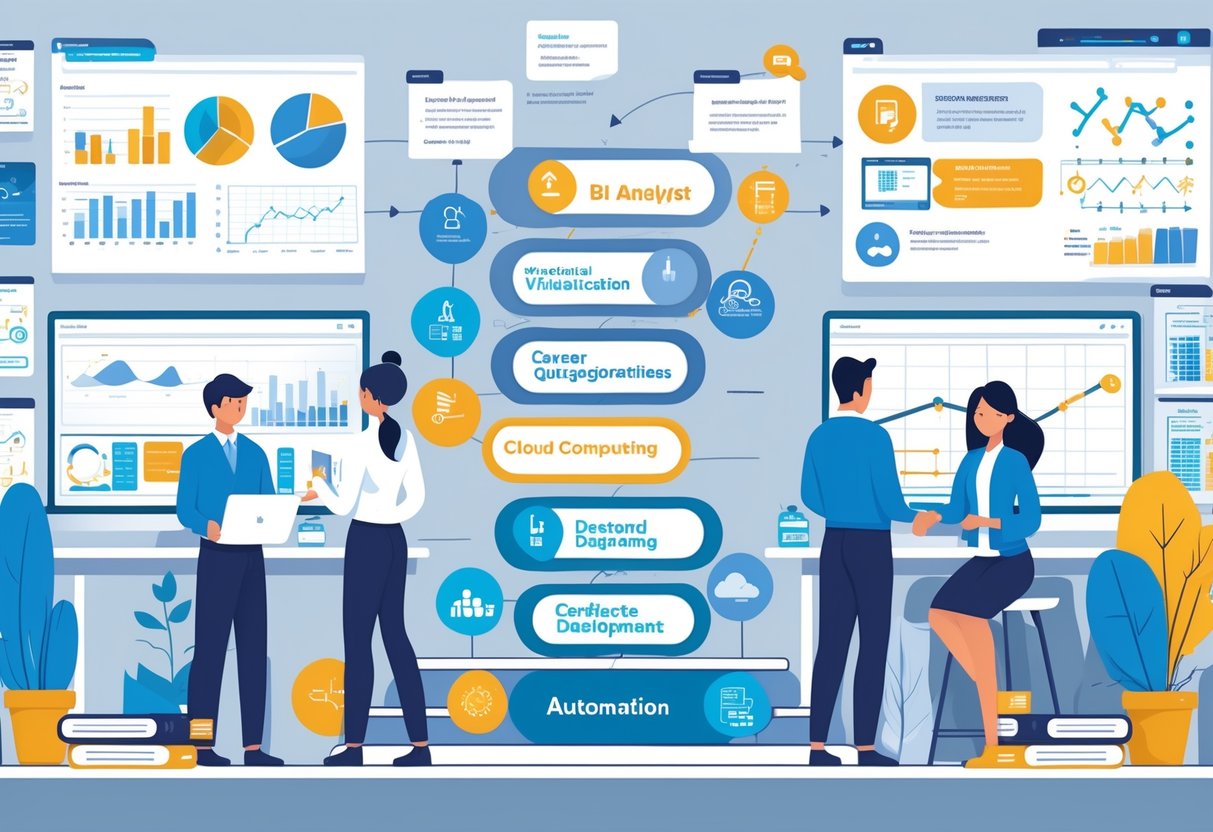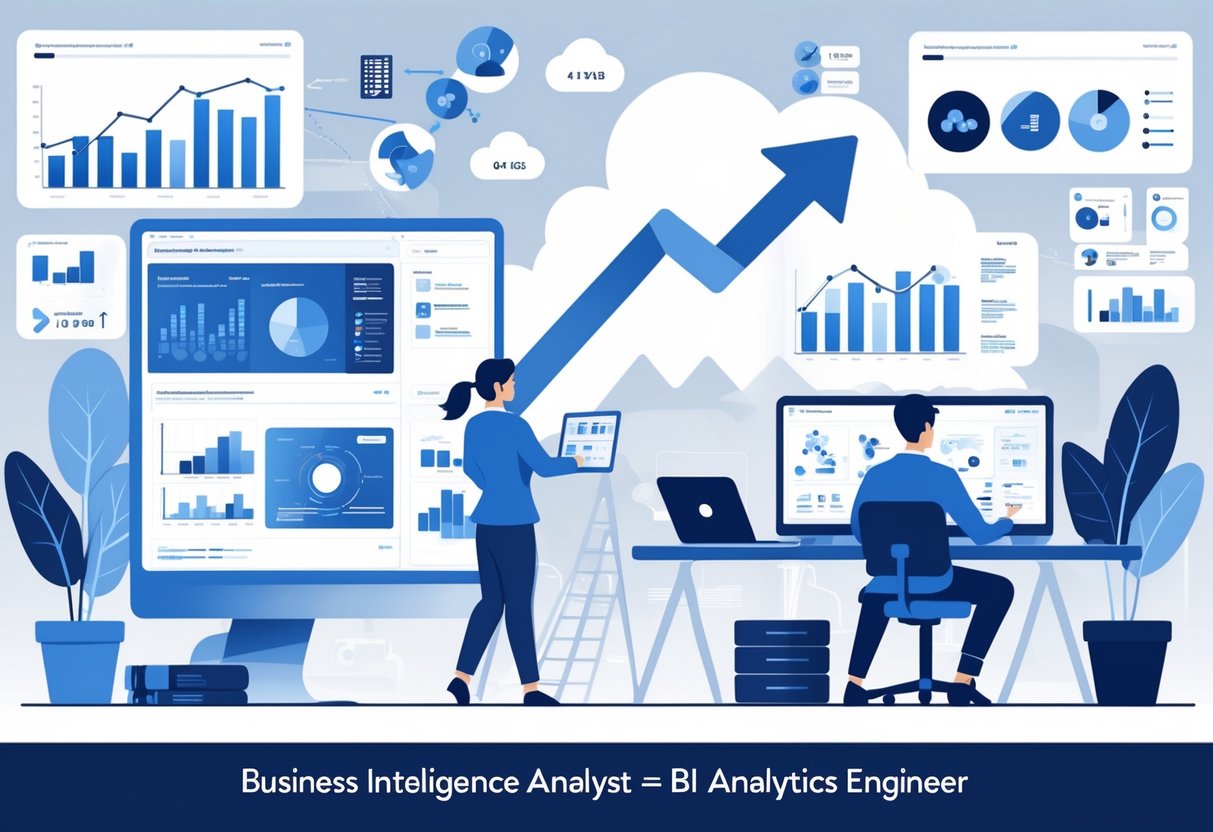Business Intelligence analysts looking to advance their careers often find themselves drawn to the emerging field of analytics engineering. This role combines the business acumen of traditional BI work with deeper technical skills in data modeling and infrastructure. The transition from BI analyst to analytics engineer is highly achievable because professionals already possess the stakeholder communication skills and business understanding that form the foundation of successful analytics engineering.

The shift requires developing specific technical competencies while leveraging existing strengths in data analysis and business requirements gathering. Unlike pure data engineering roles that focus on building data pipelines and infrastructure, analytics engineering sits at the intersection of technical implementation and business value delivery. This positioning makes it a natural progression for BI professionals who want to expand their technical capabilities without losing touch with business outcomes.
Success in this transition depends on understanding the key differences between these roles, acquiring the right technical skills, and effectively positioning existing experience during the job search process. The journey involves mastering tools like dbt and modern data warehouses while building a portfolio that demonstrates both technical proficiency and business impact.
Key Takeaways
- BI analysts already have the business communication skills that make excellent analytics engineers
- The transition requires learning data modeling, modern data warehouse tools, and data transformation frameworks
- Building a strong portfolio with real projects is essential for demonstrating technical capabilities to potential employers
Understanding the Shift: BI Analyst vs. Analytics Engineer

The move from BI analyst to analytics engineer involves taking on more technical responsibilities in data infrastructure and pipeline development. Analytics engineers bridge the gap between data engineering and data analysis, working closer to the data source while maintaining business focus.
Key Differences in Responsibilities
BI Analyst Focus:
- Creates dashboards and reports using visualization tools
- Analyzes data trends to provide business insights
- Presents findings to stakeholders in simple terms
- Performs one-time analyses for specific business questions
Analytics Engineer Focus:
- Builds and maintains data pipelines for consistent data flow
- Transforms raw data into structured formats for analysis
- Creates reusable data models that multiple teams can use
- Automates data workflows to reduce manual work
The biggest change involves moving from consuming prepared data to preparing data for others. BI analysts focus on interpreting complex data sets and creating reports, while analytics engineers ensure the data is clean and accessible.
Analytics engineers spend more time writing code and less time in meetings. They work with SQL daily to build data transformations. BI analysts use SQL too, but mainly for pulling data rather than reshaping it.
Typical Data Workflows and Tools
BI Analyst Workflow:
- Pull data from existing databases
- Clean and filter data in Excel or BI tools
- Create charts and dashboards
- Share insights with business teams
Analytics Engineer Workflow:
- Extract data from multiple sources
- Transform data using SQL and Python
- Load data into data warehouses
- Build models for analysts to use
The tool sets differ significantly between roles:
| BI Analyst Tools | Analytics Engineer Tools |
|---|---|
| Tableau, Power BI | dbt, Airflow |
| Excel, Google Sheets | Python, R |
| Basic SQL queries | Advanced SQL, data warehouses |
| Reporting platforms | Git, version control |
Analytics engineers use data warehousing solutions like Snowflake and Redshift more frequently. They also work with ETL tools that BI analysts rarely touch.
How Analytics Engineering Fits in Data Teams
Analytics engineers sit between data engineers and data analysts in most organizations. Data engineers handle the technical infrastructure. Analytics engineers focus on business logic and data modeling.
Analytics engineers collaborate with data scientists and BI analysts to understand data requirements. They translate business needs into technical solutions that work for everyone.
Team Structure:
- Data Engineers: Build the pipes that move data
- Analytics Engineers: Shape data for business use
- Data Analysts/BI Analysts: Turn data into business insights
- Business Analysts: Connect insights to business decisions
The analytics engineer role emerged because companies needed someone who understood both technical data work and business needs. They define KPIs and metrics while maintaining technical data infrastructure.
Many data teams find that having an analytics engineer reduces bottlenecks. BI analysts can focus on analysis instead of data preparation. Data engineers can work on bigger infrastructure projects.
Essential Skills for Transitioning to Analytics Engineering

Moving from BI analyst to analytics engineer requires mastering three critical skill areas: advanced technical competencies in SQL and Python, comprehensive data modeling and architecture knowledge, and proficiency with version control systems for collaborative development.
Core Technical Competencies
SQL forms the foundation of analytics engineering work. Professionals need advanced SQL skills including window functions, CTEs, and complex joins. They must understand database management across different platforms like Snowflake, BigQuery, and Redshift.
Python becomes essential for data manipulation and automation tasks. Key libraries include pandas for data processing, numpy for numerical operations, and matplotlib for basic data visualization. These tools enable efficient handling of large datasets.
Data warehouse concepts are crucial. Analytics engineers work with structured data storage systems and need to understand partitioning, indexing, and optimization strategies.
Cloud services knowledge is increasingly important. AWS platforms like S3, Redshift, and EMR are commonly used. Understanding data lakes alongside traditional data warehouses helps in designing modern analytics architectures.
Excel skills remain valuable for quick analysis and stakeholder communication. However, the focus shifts toward using it as a validation tool rather than the primary analysis platform.
Data Modeling and Architecture
Data modeling requires understanding star schemas, dimensional modeling, and normalization principles. Analytics engineers design tables that make data accessible for downstream analysis while maintaining performance and accuracy.
Statistics knowledge helps in creating meaningful metrics and KPIs. Understanding concepts like sampling, distributions, and correlation ensures data models support valid business insights.
Architecture decisions involve choosing between different storage and processing approaches. This includes understanding when to use data warehouses versus data lakes, and how to structure data pipelines for reliability and scalability.
Data engineering skills overlap significantly with analytics engineering. Knowledge of ETL processes, data quality checks, and pipeline orchestration tools becomes necessary for building robust data systems.
Performance optimization requires understanding query execution plans and indexing strategies. Analytics engineers must balance data accessibility with system performance to serve business needs effectively.
Version Control and Collaboration Tools
Git and GitHub are essential for managing code changes and collaborating with team members. Analytics engineers work with SQL files, Python scripts, and configuration files that require proper version control.
Branching strategies help manage different development environments. Understanding how to create feature branches, merge changes, and resolve conflicts ensures smooth collaboration with data engineers and other analysts.
Documentation practices become critical when working in teams. Code comments, README files, and data dictionaries help maintain shared understanding of data models and transformations.
Collaboration extends beyond technical teams. Analytics engineers must communicate with business stakeholders about data definitions, model changes, and system limitations using clear, non-technical language.
Code review processes help maintain quality standards. Learning analytics engineering best practices includes understanding how to give and receive feedback on data transformation logic and model designs.
Building Practical Experience and a Competitive Portfolio

Moving from BI analyst to analytics engineer requires demonstrating technical skills through hands-on projects and real-world experience. A strong portfolio showcasing data pipeline development, automation, and infrastructure work proves readiness for the engineering role transition.
Strategies for Gaining Hands-On Experience
Personal Projects and Open Source Contributions
Aspiring analytics engineers should start building data pipelines using their own datasets or public data sources. They can create ETL workflows that extract data from APIs, transform it using Python or SQL, and load it into databases or data warehouses.
Contributing to open source projects on GitHub provides valuable experience working with real codebases. Projects like Apache Airflow, dbt, or data visualization tools offer opportunities to learn industry standards.
Internal Company Projects
BI analysts can volunteer for technical initiatives within their current organizations. They might automate existing manual reporting processes or build data pipelines to replace spreadsheet-based workflows.
Working closely with engineering teams on data quality improvements helps bridge the gap between analysis and engineering. This collaboration provides insight into production environments and deployment processes.
Bootcamps and Online Platforms
Project-oriented data analysis courses offer structured learning with hands-on components. These programs often include real-world datasets and industry-standard tools.
Cloud platforms like AWS, Google Cloud, and Azure provide free tiers for experimenting with data processing services. Building projects using these tools demonstrates cloud competency employers value.
Portfolio Projects to Showcase Skills
End-to-End Data Pipeline Projects
A complete pipeline project should include data extraction, transformation, and loading components. The project might pull data from multiple sources, clean and validate it, then store it in a structured format for analysis.
Business intelligence analytics portfolios should demonstrate technical depth beyond traditional BI work. Analytics engineering portfolios need automated workflows, error handling, and monitoring capabilities.
Data Quality and Monitoring Systems
Projects focused on data quality validation show understanding of production concerns. These might include automated testing frameworks that check for data completeness, accuracy, and consistency.
Building monitoring dashboards that track pipeline performance and data freshness demonstrates operational awareness. These projects should include alerting mechanisms for when issues occur.
Infrastructure as Code Projects
Using tools like Terraform or CloudFormation to provision cloud resources shows infrastructure understanding. These projects prove ability to manage environments programmatically rather than through manual configuration.
Version Control and Documentation
All portfolio projects should use Git for version control with clear commit histories. Professional GitHub repositories include comprehensive README files, setup instructions, and architecture diagrams.
Code should follow best practices with proper commenting, modular design, and testing coverage. This demonstrates software engineering principles essential for analytics engineering roles.
Highlighting Practical Achievements
Quantifying Impact and Results
Portfolio descriptions should include specific metrics about project outcomes. Examples include processing time improvements, cost reductions, or data quality score increases.
Performance benchmarks help employers understand technical capabilities. Projects might show how pipeline optimizations reduced processing time from hours to minutes.
Technical Implementation Details
Documentation should explain architectural decisions and tool selections. This demonstrates strategic thinking about technology choices and trade-offs.
Code samples should highlight complex problem-solving abilities. Data cleaning logic, error handling, and optimization techniques show technical sophistication.
Business Context and Problem Solving
Each project should clearly state the business problem it addresses. This connects technical work to real-world value creation.
Success stories that describe overcoming specific challenges resonate with hiring managers. These might include debugging production issues, scaling systems, or improving reliability.
Professional Presentation
Portfolio projects need professional polish with clean code, clear documentation, and working demonstrations. Live demos or video walkthroughs can effectively showcase functionality.
Creating compelling case studies that tell the story from problem identification through solution implementation makes projects memorable to reviewers.
Leveraging Professional Development and Learning Paths

The transition from BI analyst to analytics engineer requires strategic skill development through both formal and informal learning channels. Professionals can choose between structured programs and self-directed learning, with continuous education being essential for long-term success.
Structured Learning vs. Self-Learning
Structured learning programs offer clear pathways for developing analytics engineering skills. A master’s degree in data science or computer science provides comprehensive theoretical foundations. These programs cover machine learning algorithms, statistical modeling, and advanced programming concepts.
Formal education creates accountability through deadlines and assessments. Students gain access to professors and peers for guidance. University programs often include capstone projects that demonstrate real-world application.
Self-learning offers flexibility and cost-effectiveness for working professionals. Learning Python and SQL to analyze data forms the foundation before advancing to machine learning concepts. Online platforms provide hands-on coding environments without local setup requirements.
Self-directed learners must create their own structure and motivation. They can focus on specific skills needed for their current role. This approach allows professionals to learn at their own pace while maintaining work responsibilities.
Relevant Certifications and Courses
Cloud platform certifications validate technical expertise in modern data environments. AWS Certified Data Analytics, Google Cloud Professional Data Engineer, and Microsoft Azure Data Engineer Associate demonstrate practical skills to employers.
Popular Learning Platforms:
- Coursera: University-partnered programs with structured curricula
- Udacity: Project-based nanodegrees with mentor support
- Pluralsight: Technology-focused courses with skill assessments
Programming certifications in Python and R strengthen analytics engineering credentials. Machine learning certifications from vendors like AWS or Google prove advanced analytical capabilities.
Basic skills, knowledge, and experience from typical data science job postings help determine which certifications provide the most value. Professionals should align certification choices with their target job requirements.
The Value of Continuous Learning
Technology changes rapidly in analytics engineering, making continuous learning essential. New tools, frameworks, and methodologies emerge regularly. Professionals must stay current to remain competitive.
Transferable skills from BI work provide a foundation for ongoing development. SQL expertise translates directly to analytics engineering roles. Business domain knowledge remains valuable when building data solutions.
Data science and machine learning fields evolve through research and industry innovation. Following industry blogs, attending conferences, and participating in online communities keeps skills current.
Continuous learning builds confidence when tackling new technical challenges. It enables professionals to adapt to changing job requirements and advance their careers over time.
Navigating the Job Market and Networking Opportunities

The transition from BI analyst to analytics engineer requires a strategic approach to job searching and professional networking. Building the right connections and presenting your skills effectively will help you secure analytics engineering positions faster.
Optimizing Your Resume and Online Presence
Your resume needs to highlight technical skills that matter for analytics engineering roles. Focus on data pipeline experience, SQL expertise, and any programming languages you know.
Key resume elements to emphasize:
- ETL/ELT processes and tools
- Cloud platforms (AWS, GCP, Azure)
- Data modeling and warehousing
- Python, SQL, or R programming
- Version control systems like Git
Update your LinkedIn profile with relevant keywords that recruiters search for. Include terms like “data pipelines,” “analytics engineering,” and specific tools you use.
Create a portfolio on GitHub showing your data engineering projects. Include examples of data transformations, pipeline automation, and dashboard creation.
Many companies post analytics engineering jobs on LinkedIn and other major job boards. Check LinkedIn, Indeed, and Glassdoor regularly for new openings.
Networking Within Data Communities
Join data science communities both online and offline to learn about job opportunities. Reddit has active data engineering subreddits where professionals share job leads and advice.
Effective networking strategies:
- Attend local Meetup groups focused on data science
- Participate in online forums and discussions
- Connect with analytics engineers on LinkedIn
- Join company-specific groups in your target industry
Professionals transitioning into analytics careers benefit from building relationships before they need them. Start conversations by asking thoughtful questions about tools and techniques.
Follow industry leaders and companies you want to work for on social media. Comment on their posts and share relevant content to increase your visibility.
Finding Analytics Engineering Roles
Analytics engineering positions often have different titles across companies. Search for roles labeled as “data engineer,” “business intelligence engineer,” or “analytics consultant.”
Where to find opportunities:
- Company career pages directly
- Tech recruiting firms specializing in data roles
- Startup job boards for smaller companies
- Internship programs that convert to full-time
Many organizations prefer candidates with some hands-on experience. Consider taking on freelance projects or internships to build your analytics engineering portfolio.
Business analytics job outlook focuses heavily on decision-making skills combined with technical expertise. Highlight both your analytical thinking and technical abilities when applying.
Set up job alerts on multiple platforms to catch new postings quickly. Analytics engineering roles can fill fast, especially at popular companies.
Excelling in the Analytics Engineer Role

Success as an analytics engineer requires mastering three core areas: converting technical work into measurable business value, building strong communication and problem-solving capabilities, and staying current with rapidly changing data technologies and architectures.
Translating Insights into Business Impact
Analytics engineers must connect their technical work directly to business outcomes. They need to understand which metrics matter most to stakeholders and how their data models affect decision-making.
The most effective analytics engineers track specific business KPIs that their work influences. They measure data quality improvements, report generation time reductions, and user adoption rates for their data products.
Key impact areas include:
- Reducing time-to-insight for business teams
- Improving data accuracy and consistency
- Enabling self-service analytics capabilities
- Streamlining reporting processes
They document how their data models support critical business functions. For example, they show how customer segmentation models help marketing teams increase conversion rates by 15%.
Analytics engineers also communicate ROI in business terms. Instead of focusing on technical metrics, they explain how faster query performance saves analyst time and reduces operational costs.
Developing Communication and Problem-Solving Skills
Strong communication skills separate good analytics engineers from great ones. They must explain complex technical concepts to non-technical stakeholders in simple terms.
Effective analytics engineers ask the right questions before building solutions. They work with business users to understand the real problems behind data requests, not just the surface-level requirements.
Essential communication practices:
- Regular check-ins with data consumers
- Clear documentation of data model logic
- Proactive updates about data issues or changes
- Training sessions for new data products
Critical thinking becomes crucial when designing data architectures. Analytics engineers evaluate trade-offs between different modeling approaches and choose solutions that balance performance, maintainability, and business needs.
They develop systematic problem-solving approaches for data quality issues. This includes creating standardized testing procedures and establishing clear escalation paths when problems arise.
Adapting to Evolving Data Architectures
Modern data architectures change rapidly, requiring analytics engineers to stay current with new technologies and best practices. They must understand how tools like Power BI, Tableau, and various data warehousing platforms fit into the broader data ecosystem.
Analytics engineers focus on learning transferable concepts rather than memorizing specific tool features. They understand data modeling principles that apply across different platforms and technologies.
Key technical areas to master:
- Cloud data warehousing (Snowflake, BigQuery, Redshift)
- Data transformation tools (dbt, Dataform)
- Version control and deployment practices
- Data quality monitoring and testing
They build expertise in data engineering role fundamentals while maintaining their analytics focus. This includes understanding data pipeline concepts, ETL processes, and data governance practices.
Successful analytics engineers create learning plans that balance immediate job requirements with longer-term career growth. They allocate time each week to explore new tools and techniques that could improve their current work.
Frequently Asked Questions
Moving from BI analyst to analytics engineer involves mastering data modeling concepts, learning transformation tools like dbt, and developing stronger programming skills. The transition typically requires 6-12 months of focused learning and hands-on practice with modern data stack technologies.
What skills are required to move from a BI Analyst to an Analytics Engineer role?
Analytics engineers need strong SQL skills beyond basic querying. They must understand complex joins, window functions, and advanced data manipulation techniques. Most BI analysts already have solid SQL foundations to build upon.
Data modeling becomes crucial for analytics engineers. They need to understand facts and dimensions, star schemas, slowly changing dimensions, and data normalization. Analytics engineers create data models that allow analysts to easily answer business questions.
Programming skills in Python or R help with automation and complex data transformations. While not always required, these languages expand problem-solving capabilities beyond SQL limitations.
Modern data transformation tools like dbt are essential. Analytics engineers use dbt to build modular, tested, and documented data models. They also need familiarity with cloud data warehouses like Snowflake, BigQuery, or Redshift.
Version control with Git becomes important for managing code changes. Analytics engineers work with development workflows that require tracking modifications and collaborating with team members.
What is the typical career path for transitioning from BI Analyst to Analytics Engineer?
Most BI analysts start by learning advanced SQL concepts and data modeling principles. They spend 2-3 months deepening their understanding of dimensional modeling and database design patterns.
The next phase involves learning dbt and modern data transformation practices. This typically takes 3-4 months of hands-on practice building data models and implementing testing frameworks.
Cloud data warehouse training follows dbt mastery. BI analysts spend time understanding how Snowflake, BigQuery, or similar platforms handle data storage, compute, and optimization.
Many professionals take on hybrid projects within their current role. They gradually take ownership of upstream data modeling tasks while maintaining their existing BI responsibilities.
The final transition happens when they secure an analytics engineer position. This usually occurs 6-12 months after beginning focused skill development, depending on learning pace and available opportunities.
What are the differences in responsibilities between a BI Analyst and an Analytics Engineer?
BI analysts focus primarily on creating reports, dashboards, and visualizations for business users. They consume data that others have prepared and transform it into actionable insights through visual tools.
Analytics engineers work upstream in the data pipeline. They design and build the data models that BI analysts and data analysts use for their work. Their focus shifts from consuming data to producing clean, reliable datasets.
Data quality becomes a core responsibility for analytics engineers. They implement testing frameworks, monitor data freshness, and ensure downstream users receive accurate information. BI analysts typically report data quality issues rather than fix them.
Analytics engineers collaborate more closely with data engineers and software developers. They participate in code reviews, follow development best practices, and work within engineering workflows that BI analysts rarely encounter.
Business stakeholder interaction changes significantly. While BI analysts frequently present findings to business users, analytics engineers focus more on understanding requirements and building scalable solutions behind the scenes.
What education or certifications will support a BI Analyst looking to become an Analytics Engineer?
dbt certification provides the most direct value for aspiring analytics engineers. The dbt Analytics Engineering Certification demonstrates proficiency with the primary tool used in most analytics engineering roles.
Cloud data warehouse certifications from Snowflake, Google Cloud, or AWS validate technical skills. These certifications show employers that candidates understand modern data infrastructure and can work effectively with cloud platforms.
Data modeling courses from universities or online platforms build essential theoretical knowledge. Programs covering dimensional modeling, data warehouse design, and database optimization provide strong foundations.
Programming bootcamps focusing on SQL and Python help bridge technical gaps. While formal computer science degrees aren’t required, structured learning programs accelerate skill development.
Analytics engineering bootcamps offer comprehensive training paths. Programs like those offered by data education companies provide hands-on experience with real-world projects and modern data stack technologies.
How can a BI Analyst gain practical experience in Analytics Engineering prior to transitioning?
Volunteering to build data models within their current organization provides hands-on experience. BI analysts can offer to create upstream datasets that multiple team members can use for their reporting needs.
Personal projects using public datasets demonstrate analytics engineering skills. Building end-to-end data pipelines with tools like dbt and cloud warehouses creates portfolio pieces that showcase technical capabilities.
Contributing to open-source dbt packages or data projects builds credibility. These contributions show potential employers that candidates can work with modern tools and collaborate on technical projects.
Cross-training with existing analytics engineers accelerates learning. BI analysts can shadow analytics engineering work, participate in code reviews, and gradually take on modeling tasks under supervision.
Internal tool migration projects offer transition opportunities. When organizations upgrade their data stack, BI analysts can volunteer to help rebuild models and processes using modern approaches.
Are there specific industries or projects that are beneficial for a BI Analyst to focus on to become an Analytics Engineer?
E-commerce companies often have complex data modeling needs that provide excellent learning opportunities. These organizations typically use modern data stacks and have sophisticated analytics engineering teams. You can practice relevant skills with hands-on exercises or explore industry-focused premium projects.
Financial services firms require robust data governance and quality controls. Working in finance helps BI analysts understand compliance requirements and advanced data modeling concepts that analytics engineers must master. For more on data governance standards, see the U.S. Securities and Exchange Commission or European Banking Authority.
Technology companies embrace analytics engineering practices early. These environments provide exposure to cutting-edge tools, methodologies, and best practices that define the profession. Explore games and scenario-based learning to simulate real-world tech environments.
Healthcare organizations deal with complex data relationships and regulatory requirements. This industry teaches analytics engineers how to handle sensitive data while building models that support critical business decisions. Learn more about healthcare data standards at the U.S. Department of Health & Human Services.
Subscription-based businesses generate rich behavioral data requiring sophisticated modeling. These companies often invest heavily in analytics infrastructure and provide opportunities to work with customer lifecycle data and cohort analyses. You can enroll to access targeted projects and quizzes that mirror these challenges.




